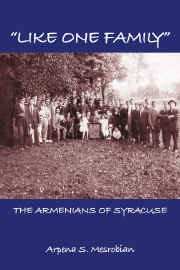
Like One Family
with a foreword by Razmik Panossian
London: Gomidas Institute, 2000,
xviii + 257 pp, photos,
ISBN 0-9535191-1-2, paperback,
UK£17.00 / US$25.00
To order please contact books@gomidas.org
"Like One Family" is
a microcosm of American-Armenian life and its narrative in many ways
mirrors that of other communities in New York, New Jersey, and New
England states.
A microcosm of the history of Armenians in America over the past one hundred years.
Starting with the earliest immigrants before World War I, this work plots the ups and downs of the Armenian community of Syracuse, New York, up to the present.
The book describes how one small community experienced the formative events of American-Armenian history. It traces the institutional developments of the early years-the establishment of churches, cultural organizations, and political parties. It follows the ruptures of the 1930s-the advent of the pro-Soviet Harachtimagan movement, the assassination of Archbishop Tourian in New York City, and the split within the Armenian Apostolic Church throughout the United States. It stays with the community though World War II, the Cold War, and more recent developments.
Drawing on numerous interviews, a wealth of letters, minutes, and other documents, as well as firsthand experience, the author delivers an intimate biography of the Syracuse family.
About the Author
Arpena Sachaklian Mesrobian is director emerita of Syracuse University Press. [2000]
From Armenian Life in America, 1900–2000, is Topic of Poconos Book Talk
Pocono Manor, Pennsylvania (27 July 2000)—Participants in the 52d annual Armenian Week in the Poconos gathered on Thursday, 27 July, to listen to Arpena S. Mersobian discuss her book, "Like One Family": The Armenians of Syracuse.
Mesrobian explained that her book is based on caches of documents people have left behind, her own personal remembrances, and another very important source: her interviews over the years with longtime members of the Syracuse community, many of whom are no longer alive. She urged others likewise to systematically interview elders about the early history of their communities.
The topics covered in "Like One Family" range from community politics (how families and friends were driven apart by the church split of 1933) to home life (how children’s ailments were treated with an olive oil and pepper mixture applied to the chest, covered with several layers of undershirts to keep the wool blanket from getting soiled).
Mesrobian’s presentation generated many questions from enthusiastic participants. Jack Papazian of Ambler, Pennsylvania, for example, wanted to know what kind of work drew Armenians to Syracuse in the first place. Mesrobian referred to the textile mills of Syracuse, as well as other industries discussed in her book. She noted that Armenians have sometimes moved to Syracuse to study or teach at the university; she observed, however, that people with a higher education have tended to avoid getting involved in Armenian community life in Syracuse.
Mesrobian is director emerita of the Syracuse University Press. Her richly illustrated book was published this year by the Gomidas Institute. It features a foreword by Razmik Panossian of the London School of Economics and Political Science.
Starting with the earliest immigrants before World War I, this work plots the ups and downs of the Armenian community of Syracuse, New York, up to the present.
The book describes how one small community experienced the formative events of American-Armenian history. It traces the institutional developments of the early years-the establishment of churches, cultural organizations, and political parties. It follows the ruptures of the 1930s-the advent of the pro-Soviet Harachtimagan movement, the assassination of Archbishop Tourian in New York City, and the split within the Armenian Apostolic Church throughout the United States. It stays with the community though World War II, the Cold War, and more recent developments.
Drawing on numerous interviews, a wealth of letters, minutes, and other documents, as well as firsthand experience, the author delivers an intimate biography of the Syracuse family.
About the Author
Arpena Sachaklian Mesrobian is director emerita of Syracuse University Press. [2000]
From Armenian Life in America, 1900–2000, is Topic of Poconos Book Talk
Pocono Manor, Pennsylvania (27 July 2000)—Participants in the 52d annual Armenian Week in the Poconos gathered on Thursday, 27 July, to listen to Arpena S. Mersobian discuss her book, "Like One Family": The Armenians of Syracuse.
Mesrobian explained that her book is based on caches of documents people have left behind, her own personal remembrances, and another very important source: her interviews over the years with longtime members of the Syracuse community, many of whom are no longer alive. She urged others likewise to systematically interview elders about the early history of their communities.
The topics covered in "Like One Family" range from community politics (how families and friends were driven apart by the church split of 1933) to home life (how children’s ailments were treated with an olive oil and pepper mixture applied to the chest, covered with several layers of undershirts to keep the wool blanket from getting soiled).
Mesrobian’s presentation generated many questions from enthusiastic participants. Jack Papazian of Ambler, Pennsylvania, for example, wanted to know what kind of work drew Armenians to Syracuse in the first place. Mesrobian referred to the textile mills of Syracuse, as well as other industries discussed in her book. She noted that Armenians have sometimes moved to Syracuse to study or teach at the university; she observed, however, that people with a higher education have tended to avoid getting involved in Armenian community life in Syracuse.
Mesrobian is director emerita of the Syracuse University Press. Her richly illustrated book was published this year by the Gomidas Institute. It features a foreword by Razmik Panossian of the London School of Economics and Political Science.